
More than a decade after its debut, the Phenom 300 continues to lead the light jet segment. It’s no mystery why the Phenom 300 has been the bestselling light jet for eight straight years. Its elegant design offers flexible, comfortable passenger accommodations while its cutting-edge technology offers a top-quality flying experience for the pilot. Plus, its efficiency makes it one of the most cost-effective aircraft in cost per available seat mile.
For owner-operators, this single-pilot light jet is staggeringly efficient, cost-effective, and dependable as well as a gorgeous example of functional aeronautical design. The updated Phenom 300E, which made its debut at the 2017 National Business Aviation Association conference and exhibition in Las Vegas, Nevada, continues to strengthen the Phenom 300’s reputation as the flagship of Embraer’s fleet and the bestselling light jet in the world. This “enhanced” version of the original Phenom 300 gracefully updates an already near-perfect machine with the latest technology and offers even more luxurious finish options.
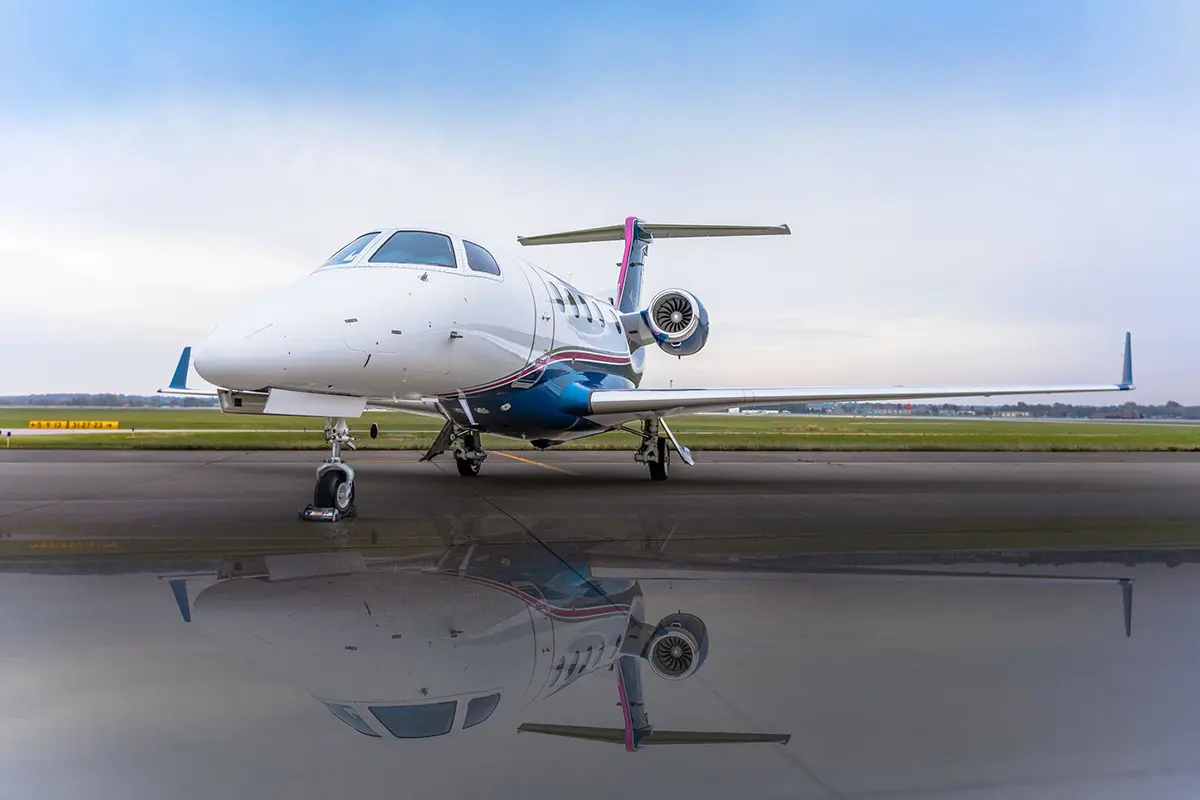
At the turn of the 21st century, the recently privatized Brazilian aerospace conglomerate Embraer S.A. shifted its focus from military and commercial aircraft production to the business jet market. Its first offering was the Legacy 600, introduced at the 2000 Farnborough Airshow as a business jet variant of its already commercially successful Embraer Regional Jet. In 2005, at the annual NBAA convention, Embraer announced the Phenom 100 and Phenom 300. In 2008, Embraer began production of the Phenom 100, a very light jet similar to the Eclipse 500, and subsequently in 2009 rolled out its “big brother,” the Phenom 300. Both jets were “clean sheet” designs rather than upgrades of their regional jet offerings, with the Phenom 300 sporting more powerful engines and a swept wing with spoilers and winglets.
Embraer gambled on the simultaneous development of the Phenom 100 and 300, hoping to take advantage of both an entry-level option and a suitable upgrade for customers in the business jet market. Both models sport a novel oval-shaped fuselage (versus the customary round design) and luxury interiors designed by BMW. The smaller Phenom 100 proved a worthy opponent to Cessna’s Citation Mustang and the Cirrus Vision SF50, while the larger Phenom 300 held its own against Textron’s Cessna Citation CJ3 and CJ4 and Bombardier’s Learjet 70. In the years since, the Phenom 300E has defended its position against laudable new entries into the market like Switzerland’s Pilatus PC-24. Embraer’s business jet catalogue now also includes the midsize Legacy 450 and Legacy 500, which evolved to the Praetor 500, and the Praetor 600.
Since its release into service in 2009, the Phenom 300 series has been the most delivered business jet on the market, recording over 530 deliveries to date. In 2019 alone, Embraer delivered a total of 51 Phenom 300 and 300E aircraft, which exceeded the number of deliveries of its closest competitor by more than 20%, a benchmark it has achieved for the past eight years. The aircraft is in operation in more than 30 countries, both privately and commercially, and has accumulated more than one million flight hours.[1]
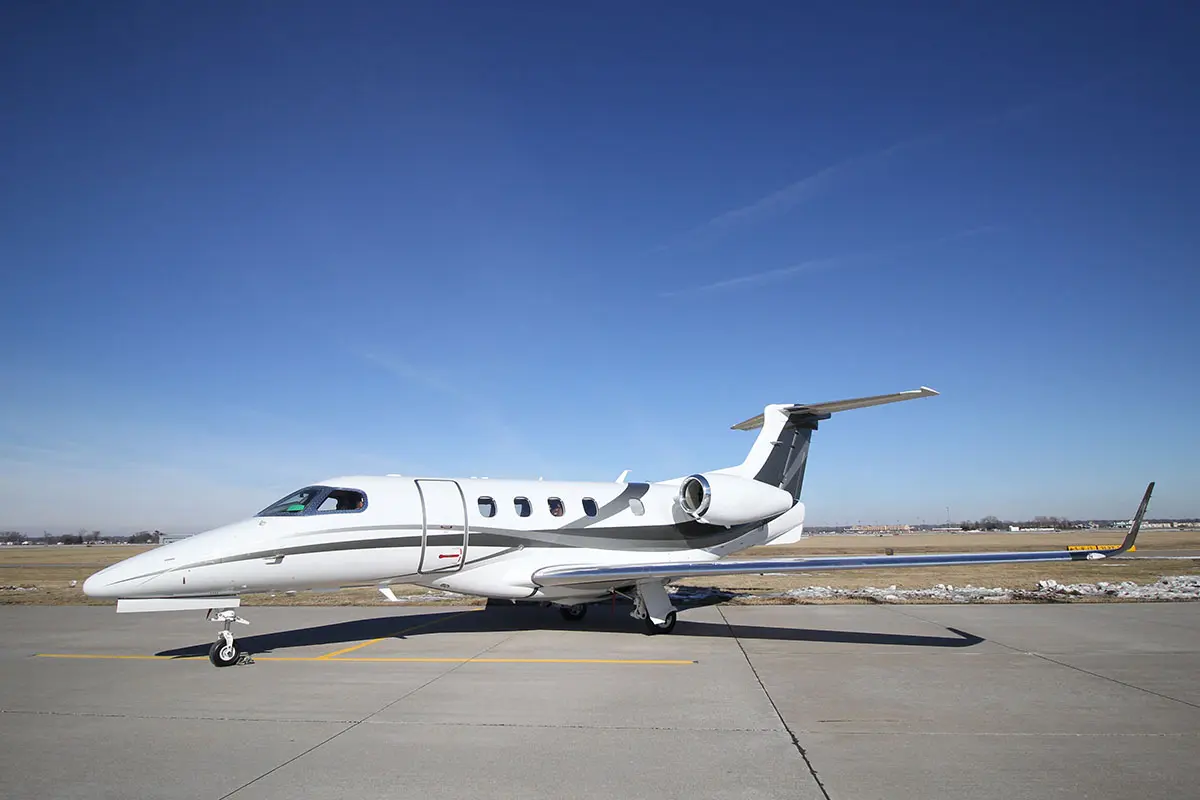 Although the Phenom 300 was already the best-selling light jet in the world, Embraer’s 2017 updates helped further its goal of delivering the ultimate customer experience in business aviation. While the 300E offers performance, comfort, and technology enhancements, the success of the Phenom 300 series comes from its foundation of power and precision.
Although the Phenom 300 was already the best-selling light jet in the world, Embraer’s 2017 updates helped further its goal of delivering the ultimate customer experience in business aviation. While the 300E offers performance, comfort, and technology enhancements, the success of the Phenom 300 series comes from its foundation of power and precision.
According to the tech sheets provided on Embraer’s website, all Phenom 300s begin with two remarkably powerful and efficient Pratt & Whitney Canada PW535E turbofan engines. On the 300 models, each engine produces 3,360 pounds of thrust; the 300E increases this to 3,478 pounds of thrust each. The impressive engine efficiency reduces the noise footprint, achieves better fuel economy, and produces fewer emissions than its competitors. The powerful engines and innovative winglet design allow incredibly fast climb rates (up to 3,000 ft/minute). Combined with its comparatively short takeoff field length (3,209 ft versus the CJ4’s 3,410 ft takeoff requirement), the 300 series jets really shine in steep-slope approaches and “hot and high” conditions like those in Telluride, Colorado. This flexibility allows access to more airstrips in more locations, reducing wasted ground-travel time and expense.[2]
The Phenom 300 cruises at a speedy max of 446 knots; the 300E improves this to 464 knots, with a max operating altitude of 45,000 feet. They boast a five-occupant range of 1,992 and 2,010 nautical miles with NBAA IFR reserves, respectively. Originally capable of reaching a showstopping maximum Mach 0.78, the Phenom 300E increased to a maximum Mach 0.80 with the recent enhancements. The improvements edge out the CJ4 as the fastest and longest-ranged single-pilot jet in business aviation while maintaining the power, reliability, and smooth handling of the original Phenom 300 model.
Both the Phenom 300 and Phenom 300E use a traditional control yoke instead of the side stick found on craft like the Legacy 500. The newest available technical enhancements (standard on the 300E) include multiple safety feature updates and an upgraded avionics suite. Its unique Prodigy Touch Flight Deck system was developed in partnership with Garmin to bring the latest and greatest technology to the pilot’s fingertips. Most older models of the Phenom 300 outfitted with the original Garmin G1000 suite can now be upgraded with the aftermarket G1000 NXi avionics package, which came out in July of 2020 and offers many of the updated features.
Later-model Phenom 300s were delivered with the state-of-the-art Garmin G3000 suite has three 14.1-inch displays (two primary flight displays and a multifunction display) all have split-screen functionality to display maps, charts, electronic documents, system synoptics, and flight plans, alongside basic flight data. Two 5.7-inch touchscreen controllers allow seamless data entry, integrating easy-to-read icons and a simple menu structure.
The Garmin G3000 system also includes SurfaceWatch™ vertical navigation, windshear alerting weather radar with vertical scan, ground clutter suppression, and turbulence detection. The latest upgrades also incorporate a runway overrun awareness and alerting system (ROAAS), predictive windshear, Synthetic Vision System, Emergency Descent Mode, PERF, TOLD, and FAA Datacom, among others.
Both generations of the Phenom 300 series offer pilots a smooth, fun flying experience. While the fly-by-wire system can take some getting used to, the electric brakes, spoilers, and ailerons ensure consistent stopping performance on short runways that is vastly superior to hydraulic braking systems. This technology enables safe landing at steep-slope airports like London City (which has a 5.5° glideslope rather than the usual 3° slope on approach).
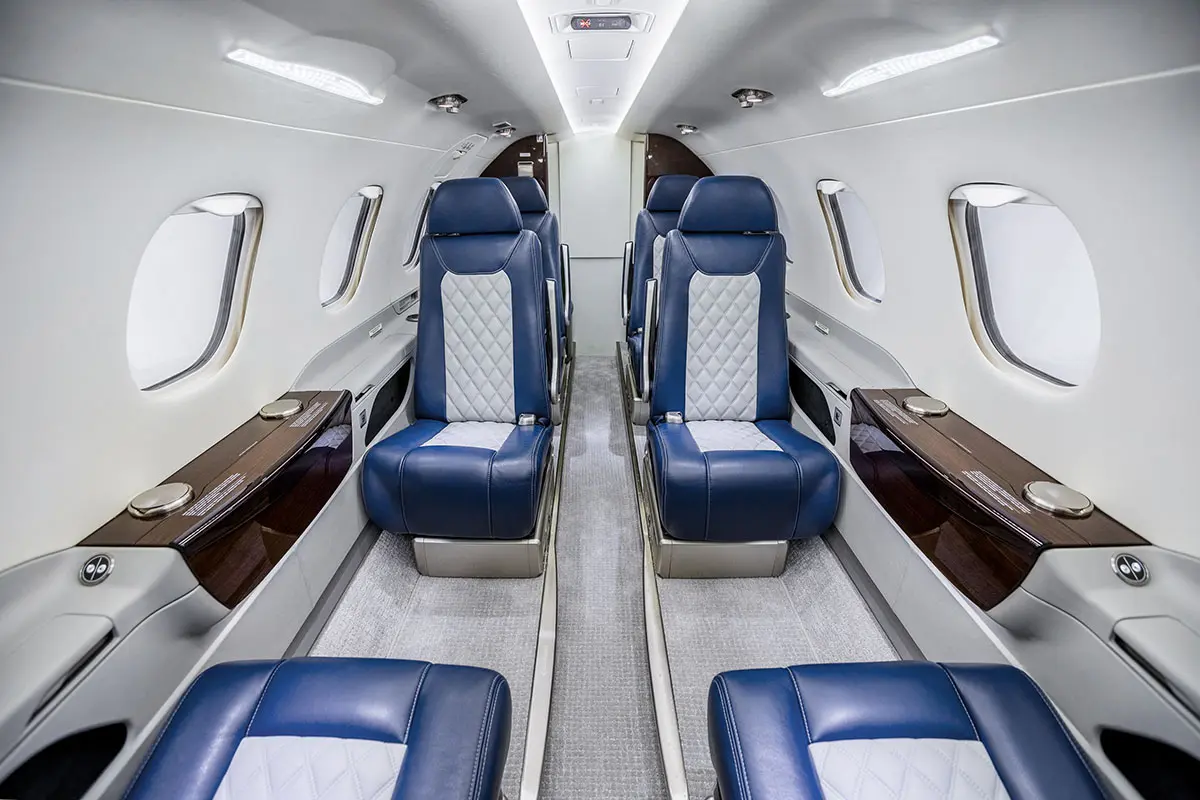
In addition to its superb flying capabilities, the Phenom 300 excels in passenger comfort due to its craftsmanship and design. In total, the craft measures 51 feet, 4 inches long and 16 feet, 9 inches, tall with a 52 ft 2 in (15.9 m) wingspan. Its Oval Lite® cross-section cabin design offers the most vertical space and legroom along with the largest windows in its class (including one in the lavatory); the innovative seat designs also allow for a more spacious, wider center aisle. In fact, the Phenom series boasts 10.5% more cabin room than the Citation CJ4 (324 cubic feet versus 293 cubic feet). Numerous seating configurations comfortably accommodate 6–10 passengers, with an optional refreshment center and a full lavatory with a sink. In addition, the Phenom 300 has a cabin altitude of 6,600 feet when the airplane is at 45,000 ft, which beats any aircraft in its class.
The swept-wing design and improved wing loading reduce turbulence and provide a smoother ride than the straight-winged aircraft design used by the Citation CJ3 and Citation CJ4, while two cargo holds securely tuck away 84 cubic feet of stowed baggage. Due to its more efficient engines, the Phenom 300 also has a quieter cabin than its competitors. Although it has always offered top-end luxury design, comfort, and style, the new premium interior Bossa Nova package, introduced with the Phenom 300E, offers even more for passenger comfort; the enhanced headrests, retractable armrests, adjustable thigh bolsters, and custom stitching helped the enhanced package win the 2020 Private Jet Design award at the 2020 International Yacht and Aviation Awards in the Small/Medium Jets category. Customers can mix and match more than 90 material options like wood veneer, leather, carpet, fabric, and plating to personalize their aircraft interior; many of these new upgrades are also available as retrofits for the Phenom 300 series.
Announced in August of 2020, Phenom 300Es not only can be configured for numerous passenger arrangements and otherwise kitted out with specialty customized interiors but also now can be ordered with a premium ready-fit Medevac configuration for medical transport uses (300MED). Existing Phenom 300 series units can be retrofitted with the medevac interior package or upgraded interior finish and technology options.
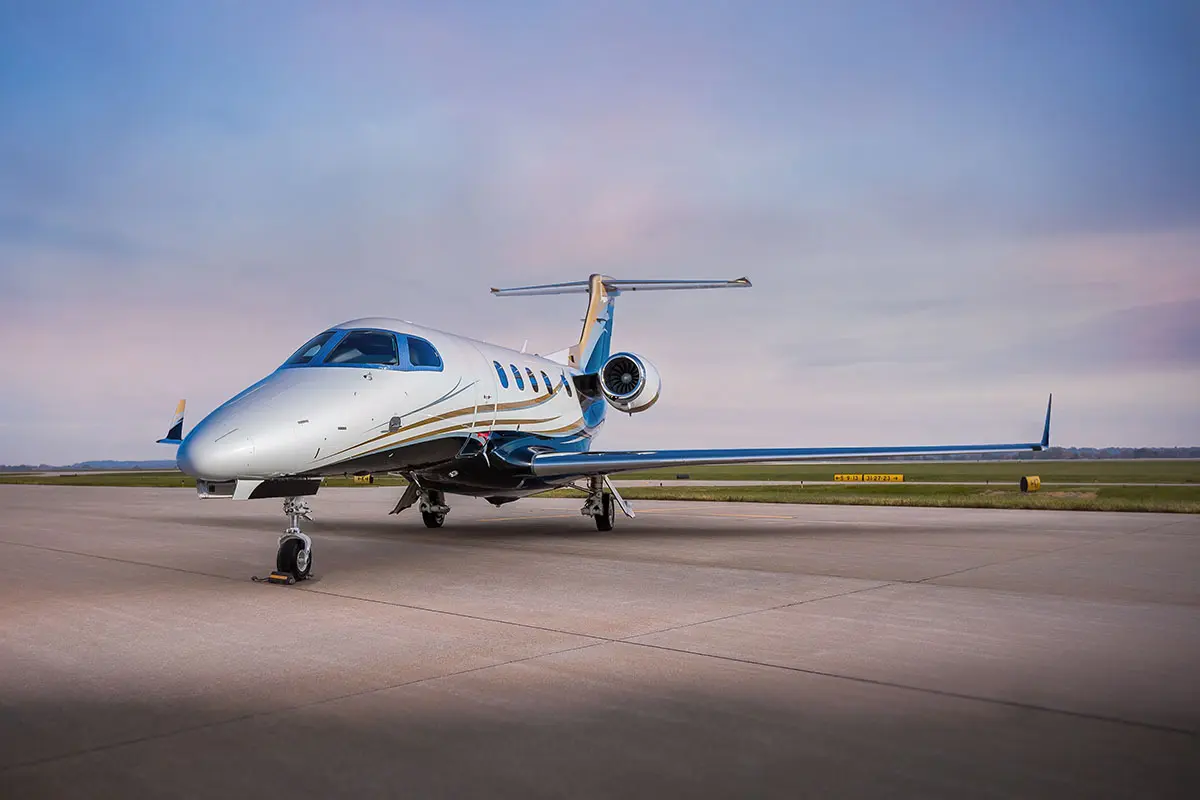
The Phenom 300 series has been popular not only with individual owner-operators but also with fractional share and charter fleet operators selling jet cards. NetJets and Flexjet both use the Phenom 300 as their core light jet option; Airshare and Nicholas Air prominently feature the Phenom 300 in their jet card and fractional programs. GrandView Aviation, Alliance Aviation, Magellan Jets, OneFlight, and other private programs also provide opportunities to coordinate travel on Phenom 300 series jets.
While commercial operation requires a two-person flight crew, privately owned Phenom 300s are rated for single-pilot operation, allowing maximum flexibility for owner-operators whose needs have outgrown very light jets like the Phenom 100, Citation Mustang, and Citation CJ1 or turboprops like the King Air.
Upgrading to a light business jet like the Phenom 300 series can enable your business to reduce or avoid commercial airline travel, slashing wasted time navigating TSA, flight delays, and potential exposure to health hazards. Aircraft used for qualified business purposes, such as Part 91 business use flights, can generally be depreciated under a modified accelerated cost recovery system over a period of five years or using the alternative depreciation system with a six-year recovery period (although non-business uses of the aircraft can impact the allowable yearly depreciation deduction). In addition, the 2017 Tax Cuts & Jobs Act enables qualified individuals and businesses to deduct up to 100 percent of the cost of a new or used aircraft purchased after September 27, 2017 and placed in service before January 1, 2023. In short, there’s no time like the present to take a look at the benefits and cost savings of purchasing a Phenom 300 or other light business jet.
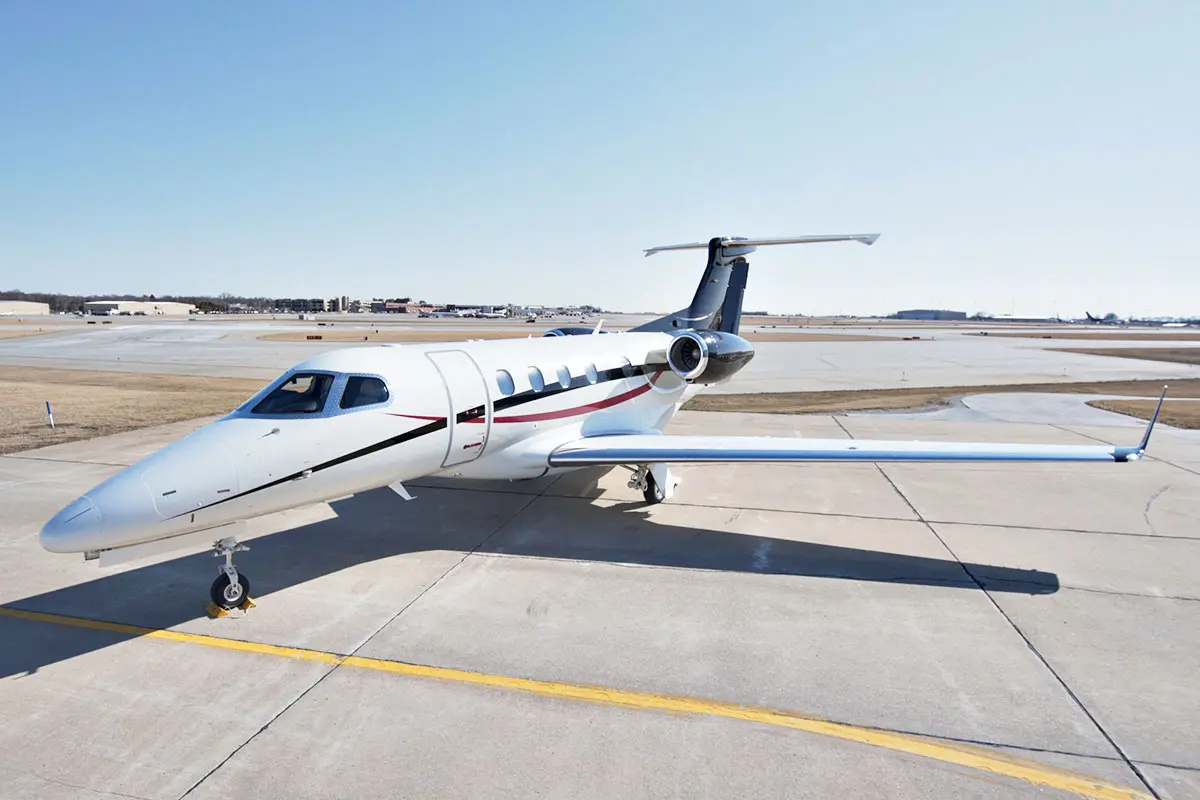
One area in which the Phenom 300 series significantly outperforms competitors is in value retention. Let’s take a look at a pre-owned Phenom 300’s three-year depreciation vs. a Citation CJ4. A 2012 Phenom 300 currently sells for about 89% of its value three years ago (2012 Phenom 300 value in 2017 was $6.2mm, current retail value is $5.5mm). Compare that to a 2012 Citation CJ4, which is currently selling for just 79% of their value three years ago (2012 CJ4 value in 2017 was $6.3mm, current retail value is $5mm). Bottom line, a buyer who chose to purchase a 2012 Phenom 300 vs. a 2012 CJ4 back in 2017 saved a whopping $600k in depreciation in just three years.
In addition to retaining its value, the Phenom 300 series aircraft are known for its outstanding dispatch reliability. This makes it a favorite of fractional operators like Flexjet, who have lauded the aircraft for its 99 percent dispatch reliability across its 300 aircraft fleet.[3]
The Phenom 300 series’ design and technology give these jets some advantages over the competition that may balance out the higher purchase price in both the new and pre-owned markets. Flexjet observed that owners view the aircraft as a superior value due to its cabin room, range, short-field performance, and baggage capacity. Since the Phenom can use shorter runways and operate at higher altitudes than larger jets and in extreme temperatures, it can use airports that other jets cannot, allowing its users extra flexibility. Because of their extraordinary reliability, retention of value, and economical operation costs, used Phenom 300s are an excellent value.
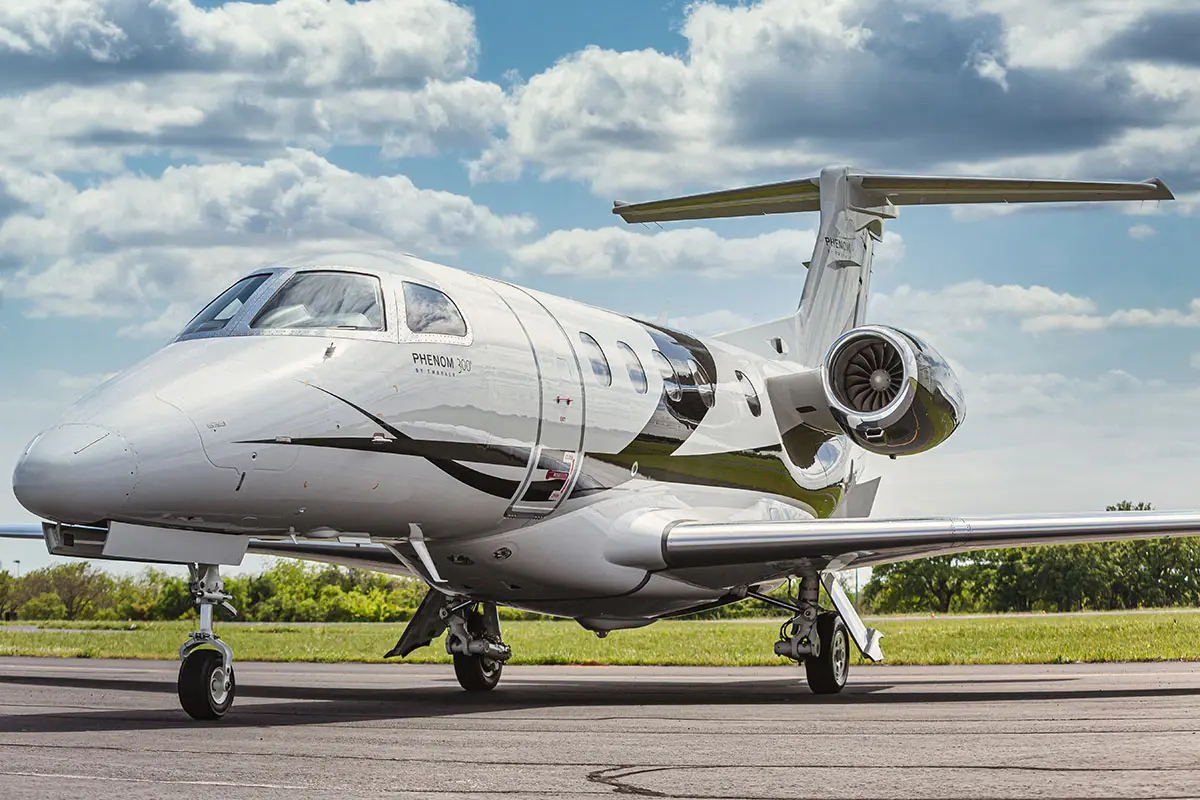
The Phenom 300 series also offers comparatively low maintenance and operation costs, offering a lower total variable cost (an aggregate of fuel expense, maintenance labor expense, scheduled parts expense, and miscellaneous trip expense) than the Citation Cj4, according to Conklin & de Decker. Innovations such as airline-like single-point refueling and the category’s only externally serviced lavatory improve the ease and speed of day-to-day operation and reduce turnaround times for the Phenom 300 and 300E.
When it is time for scheduled maintenance, the Phenom series’ high-tech SmartProbes™ and a fully integrated central maintenance computer minimize downtime. Embraer’s global support platform, which authorizes more than 70 owned and authorized service centers across the globe, encompasses a network of highly trained technicians to guarantee the best quality of service worldwide rather than requiring dealer-direct servicing.
The Phenom 300 series aircraft require 12, 24, 36, 48, 60, 72, 84, 96, 108, and 120-month inspections. The 120-month (10 year) inspection is the largest and most thorough in the Phenom maintenance manuals, requiring the complete removal of the interior, opening of all inspection panels, and removal and overhaul of gear. It is also an excellent opportunity to replace or repair passenger seat coverings, upgrade entertainment or avionics systems, and add any other options that have become available since original delivery of the craft. This milestone service generally involves three to four weeks of downtime and costs around $250,000. However, many other comparable aircraft require significant service every four years that can cost around $150,000 with similar downtime for each event. Over the long haul, the service requirements for the Phenom 300 series are more economical and require significantly less overall downtime.
As the major 120-month inspections come due on the original release aircraft, Embraer has been able to review the series’ per-hour performance and benchmark maintenance requirements. You can find more information on what to expect during a Phenom 120-month inspection here. In July 2020, Embraer made revisions to the scheduled maintenance requirements for its Phenom business jet lineup that introduced a 33% maintenance-interval improvement, bringing it to nearly double the industry average. Under the new guidelines, based on the Maintenance Steering Group (MSG-3) methodology, the intervals between stops have been extended from 600 flight hours and/or 12 months and multiples to 800 flight hours or 12 months and multiples. The revisions also optimized most of the tasks with double intervals to the longest period. Embraer forecasts that the new requirements will reduce downtime, lower maintenance costs, increase the economic life of the aircraft, and allow for more airtime.[4]
In addition to its standard warranty, in 2012 Embraer Executive Jets expanded its customer service and support solutions with the Embraer Executive Care (EEC) Engine Add-On option. This offers a “nose-to-tail maintenance solution” for owners of Phenom 100 and 300 series jets to complement the existing EEC five-year maintenance program and the Eagle Service™ Plan programs, simplifying invoice and payment processes. The engine add-on option covers scheduled line maintenance, labor, shipping charges, and expendable and consumable parts such as filters and O-rings associated with these tasks as well as one desalination wash per engine per year during a scheduled aircraft maintenance visit.
At Elliott Jets, we’ve sold and acquired numerous Phenom 100s and 300s for customers all over the world. Our parent company, Elliott Aviation, has been an authorized service center for the Phenom 100 and Phenom 300 since 2010.
References:
Bean, Larry. “The Embraer Phenom 300 Gets Upgraded to the 300E.” Robb Report, 14 Oct. 2017.
Chase, Mike. “Cessna Citation CJ4 vs Embraer Phenom 300/300E.” AvBuyer.com, 01 Oct. 2018.
Clarke, Chris. “The Very Best Light Jets in the Sky Today.” Popular Mechanics, 07 Jun. 2018.
Croft, John. “Embraer Phenom 300: Bolder Big Brother.” Flightglobal.com, 12 May 2008.
“Embraer Phenom 300 was the most delivered light jet last year.” Aerospace Manufacturing, 21 Feb. 2020.
Embraer boosts Phenom maintenance to 800 flight hours. Embraer.com, 27 Jul. 2020.
“Phenom 300E.” Embraer.com, n.d.
Flying with Rich. “#11 The Amazing Phenom 300!” YouTube.com. 28 Apr. 2020. https://www.youtube.com/watch?v=rFqSdgcZt7Q
Huber, Mark. “Embraer Phenom 300.” Business Jet Traveler, May 2017.
“The Embraer Phenom 300 offers six configurations. What’s the difference?” Private Jet Card Comparisons, 1 Feb. 2020.
Mark, Rob. “A Look Inside the Phenom 300E.” Flying. 22 Jan. 2019.
Trautvetter , Chad. “Vref: T-props, Phenom 300E Set To Hold Highest Values.” AIN Online.com. 10 Jun. 2019.
Zhang, Benjamin. “I flew on a $10 million Embraer Phenom 300E and I now understand why it’s the most popular private jet in the world.” Business Insider, 1 May 2019.
[1] “Embraer Phenom 300 was the most delivered light jet last year.” Aerospace Manufacturing, 21 Feb. 2020.
[2] Chase, Mike. “Cessna Citation CJ4 vs Embraer Phenom 300/300E.” AvBuyer.com, 01 Oct. 2018.
[3] Huber, Mark. “Embraer Phenom 300.” Business Jet Traveler, May 2017.
[4] Embraer boosts Phenom maintenance to 800 flight hours. Embraer.com, 27 Jul. 2020.